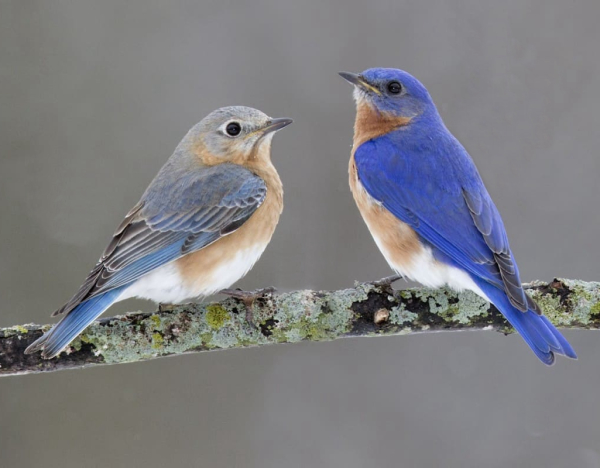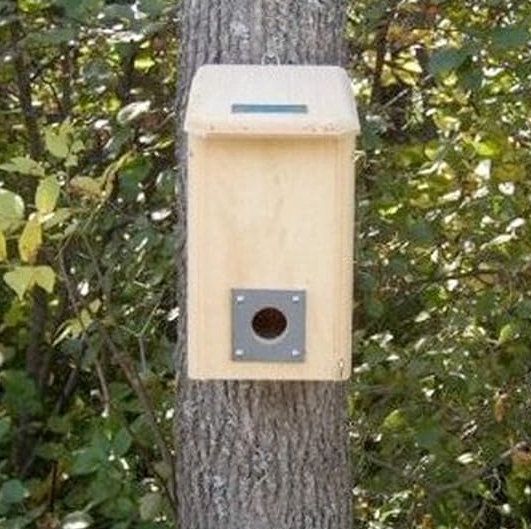
Cold weather can lead cavity nesting birds to look for shelter overnight and during storms. That’s when a roost box can be an important benefit to a pair of Eastern Bluebirds and other birds during freezing temperatures (photo by Adam Betuel).

A unique convertible roost box–nest box is available from BestNest, and is described and illustrated in the Products section of this issue.
|
As temperatures cool during fall, some birds begin to use nest boxes as overnight havens – as “roost boxes” – and they use these boxes increasingly as winter-like weather approaches. This has long been a secondary use of nest boxes, but during recent years some birders and nest box builders have improved the process in small but excellent ways to serve cold-weather birds by building a focused roost box. A roost box can be a great way to attract some favorite birds to your yard or property, while providing a considerable benefit to the birds that use it in the process. And who wouldn’t want to provide a roost box for a small owl, bluebirds, or chickadees to name a few of the birds that may benefit.
That’s exactly why birders are beginning to install specialized roost boxes. In nature, some birds – especially cavity nesting birds such as owls, woodpeckers, titmice, bluebirds, and chickadees – seek out cavities where they can stay out of the wind, snow, and sleet, and where their body heat can warm the small area of a cavity to help them conserve precious energy when resources are scarcest. Some smaller birds such as bluebirds and chickadees are also known to roost collectively in a single roost site with several of them huddling together during severe weather.
Let’s start with a songbird roost box, then lead up to owl-sized roost boxes. To start with, you can build or buy a focused roost box. The main difference between a specialized roost box and a nest box is that roost boxes have their entrance hole positioned near the bottom of the box to help keep warm air created by the bird or birds inside the box. Their body heat will rise inside the roost box, creating a more favorable roost site. (Conversely, the warmer air escapes from the entrance hole positioned at the top of a nest box.)
The second improvement to a roost box is the addition of 1 or 2 cross bars that are installed horizontally a few inches above the entrance hole, so roosting birds can perch where the warmer air is contained. After learning about these 2 relatively simple improvements, it makes sense to provide a specialized roost box, and it can really help birds to conserve needed energy during any cool night, but especially during cold nights and during daytime snowstorms or windstorms. A recent option is to build or buy a “convertible box,” which can easily be switched from a nest box to a roost box, and back again with the changing seasons.
A Convertible Box
A really impressive option is a convertible roost box–nest box, which allows you to reposition the front panel of the box where the entrance hole is positioned. This unique design allows you to position the hole high during the nesting season, then reverse the panel so the entrance hole is low during the cold weather roosting period. We are only aware of one model of “reversible” roost box–nest box on the market now, which is made for cavity-using songbirds including bluebirds, small woodpeckers, titmice, and chickadees, and it’s available from BestNest (see information in the Products description in this issue).
A Modified Roost Box–Nest Box
Another option is to modify a nest box into a reversible roost box–nest box, which is pretty simple. Just remove the screws or nails that attach the front panel to the rest of the nest box; then flip the front panel upside down so the entrance hole is at the bottom, and screw it back into place. (We suggest reinstalling with screws, which should make taking them out and reinstalling them a bit easier when you want to reverse the panel again.) After you have done this once, it’s easier thereafter; but you may find an even better way to make the flip. For now, you get the idea – give it a try.
Modifying an existing nest box is a great way to convert a bluebird house into a roost box for bluebirds and other birds after the nesting season. And at this time, it’s the only option if you want to create a bigger roost box for small owls – screech owls, saw-whets, pygmy owls, Boreal Owls; or even larger Barn Owls. That is to say that we are not aware of any ready-made big roost boxes for sale. Therefore, it’s up to you to either convert a big nest box that you have for small owls, cavity nesting ducks, or kestrels into a big roost box for fall and wintering owls. Just remove the screws or nails on the front entrance panel, flip the panel, and replace the screws. You should also add at least 1 horizontal perch above the entrance hole so the bird(s) remain in the warmer (upper) part of the roost box.
In the meantime, we expect an enterprising company to fill the void by producing big roost boxes for sale soon. Until then, it’s really a small change to modify an existing big nest box into a convertible box that provides an improved roosting option during cold-weather months, and a top-notch nesting site as a nest box during spring and summer. One more thing that can be helpful is to position the roost box so the entrance faces away from the dominant cold-weather wind direction, which usually means facing away from north winds.
It’s all relatively simple, but if you are successful in attracting a small owl or a pair of bluebirds or chickadees to utilize your roost box or boxes, that becomes a pretty special experience – definitely one to encourage. Small owls and bluebirds are migrating now, so the timing is right to prepare for their arrival. Good Luck!
Share your backyard birding experiences and photographs with The Birding Wire at editorstbw2@gmail.com